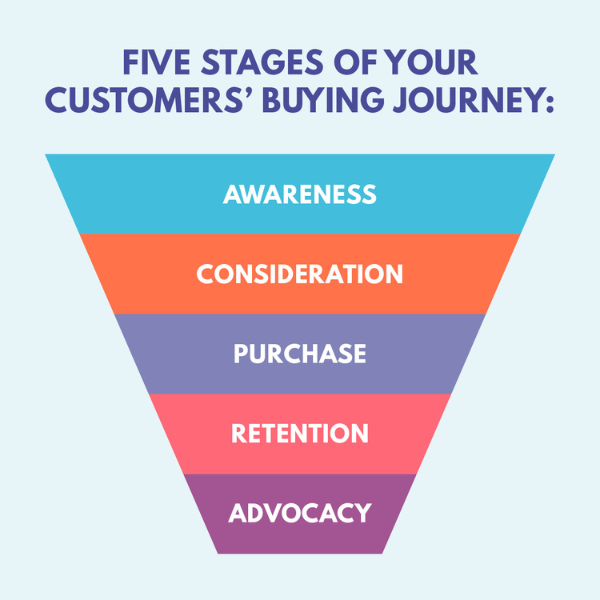Five stages of your customers' buying journey

- 02 July 2025
The customer buying journey has been subject to change and development since its first inception. As such, there are now a wide variety of models which attempt to define the journey. There are seven-step models, five-step models, funnels, flow charts, diagrams and graphs which all have their own unique take. Our overview describes the most commonly used model and provides tips and advice for your organisation to improve the customer journey at each stage.
It will come as no surprise that there is a relatively long history associated with customer journey mapping, which can be traced back to the late 1980s.
What are the five stages of the customer buying journey?
In short, the five stages of your customer's buying journey are:

- Awareness
The consumer becomes familiar with the brand through advertising, word-of-mouth or social media.
- Consideration
Realising that they have a need that must be met, the consumer actively considers whether or not to buy the product or service on offer.
- Purchase
The consumer makes the purchase.
- Retention
The customer uses the product, sometimes seeking guidance from provider or a user community, and perhaps being contacted by the provider to encourage brand loyalty.
- Advocacy
The customer spreads the word about the product – whether their opinion is positive or negative.
What is the customer buying journey?
The customer buying journey is the path your potential customer takes from looking for your products or services, to buying them, to talking about them. While there are multiple stages and models, the starting point of the journey is always the same - the customer needs something you provide
Why you should consider the customer buying journey
The purpose of this model is to help organisations visualise how customers interact with their brand. When the stages are considered in this way, they can help provide valuable insight into areas which are in need of improvement or streamlining. The customer buying journey isn’t an exact science as some of the models would have you believe. It is full of opportunities and difficulties.
The first step for all organisations is becoming aware of the experience that their organisation offers to customers, once organisations have an understanding of their customers and the journey they undertake, it is much easier to craft a more intuitive experience. Providing a smooth and easy-to-navigate customer journey holds the key to increasing customer satisfaction, sales and boosting customer retention.
Key challenges
Customers are firmly incorporating technology into their purchasing journey, undertaking buying journeys in increasingly complex ways and often using multiple channels and devices to complete a single purchase. Whilst initially it may seem as though customers using more channels means marketers have more opportunities to reach them, the reality is that customers expect to be able to use their preferred methods or channel at each stage, and at any time, adding to the complexity faced by marketers. Half of all online purchases in the US are now made on mobile devices, but 75% of in-store shoppers are using their mobile device while in-store.
Another key challenge faced by marketers is customer expectations. Customers increasingly want their journey to be truly personalised, built around their individual needs. That includes different purchasing options and ever more convenient customer service. Consumers are increasingly likely to seek out reviews from friends, family members and peers when making a purchasing decision so it is vitally important that the reputation of your organisation is positive amongst these groups. This has led to different advocacy platforms like TripAdvisor evolving and their influence on customer behaviour can't be understated.
Authenticity is another area which is becoming increasingly important to customers. Authenticity doesn’t mean that your organisation’s products have to be all-natural or hand-crafted. It means that customers expect to be engaged with on a human level, the want organisations that demonstrate understanding and empathy towards them and genuinely care about helping to solve their problems. Customers are quick to recognise organisations that treat this as a tick-box activity.
Practical solutions
To help address these key challenges, here are some practical points to take into consideration when designing each stage of the customer journey:
Awareness
Boosting customer awareness depends on understanding who your customers are and being able to reach them at the right moment, on the right platform. To optimise this, performing research is crucial. Options include customer surveys, social media outreach and analytics.
The development of analytics platforms has been truly breath-taking. These platforms can provide a wealth of information including items such as:
- Location
- Age
- Gender
- Choice of device
- Dwell time
- Conversion rate
Understanding exactly who your customers are and how they are discovering and interacting with your brand can be incredibly informative for developing strategies to increase awareness.
Advertising also presents a significant opportunity to boost awareness. There are many different types of advertising available to businesses from pay-per-click (PPC), Google Ads, search engine marketing and social media marketing to name a few. The advantages of these forms of advertising is that they can cater to almost any budget and are highly targeted.
Consideration
Increasingly, consumers have lost trust in the advertising and marketing communications of businesses. They instead, put their trust into the words and opinions of peers, particularly friends and family, when making purchases. A great way to get your brand into the consideration conversation is by prominently featuring testimonials on your various channels.
Adding your own commentary on how your organisation has helped customers can provide insight into the ethos of your business, helping customers to see your business as an authentic organisation, run by real people. Customers prefer to interact with organisations which match their values, and which are perceived as having an authentic purpose.
If you want to take things a step further, you can begin providing genuinely useful content to potential customers. This is an increasingly popular way for organisations to keep themselves in consideration throughout the course of a customers’ buying journey. Content such as product demonstrations, FAQs, blog posts and reviews can all be valuable.
Purchase
This stage is sometimes referred to as the decision stage. The customer has finished making their decision, has considered your brand against the competition and is now ready to purchase. At this stage, it helps to be as transparent as possible about costs. Extra costs on page (Think hidden shipping costs or additional taxes) is cited as the most common reason for cart abandonment.
Other notable factors which can increase cart abandonment include requiring an account for purchase and the checkout process being too complex. Optimising your checkout experience for customers can often just mean simplifying it. How much data do you really need to collect from a customer to facilitate a purchase?
Retention
After a purchase, customers want it to be as easy as possible to interact with your organisation should they require advice or support. Making sure this is easily accessible post-purchase can pay dividends – that means you shouldn’t hide the company phone number on the website just because it’s more convenient for you.
Offering and advertising cross-platform digital, social media, telephone and in-person interaction will ensure that you have all the bases covered. It also helps if your front-line staff are able to make quick decisions. Customers will soon become frustrated if your service team don’t have access to the data they need and don’t have the flexibility to help.
Being able to successfully retain customers leads to repeat purchases and (if you do a good job) advocacy of your business. According to research from Semrush, the probability of selling to an existing customer is between 60% and 70%, whilst the probability of selling to a new customer can vary from five to 20%. This shows just how significant long-term customer loyalty can be for businesses.
Advocacy
Advocacy strategies must include proactive ways to deal with criticism and showcase praise. If a negative review starts trending on social media, are you agile enough to contact that customer, assess the situation accurately and resolve their issue in a positive way? And on the other hand, can you actively seek out positive messages from key influencers and reward people for their brand loyalty?
Finding comments about your brand is the first step – this can be easily done through a free service such as Google Alerts. Keeping a close eye on your company’s social channels is also essential as it is increasingly common for customers to vent their frustrations on company social accounts.
If you want to learn more about the craft of customer experience and boost the skills on your CV at the same time, explore one of the many customer experience courses offered by CIM and book your place today! Check out our exclusive summer training discount to unlock 15% off all live training courses with half-price membership. Offer ends 17 July 2025.

- 0 views

 FAQs
FAQs
 Log in
Log in
 MyCIM
MyCIM







